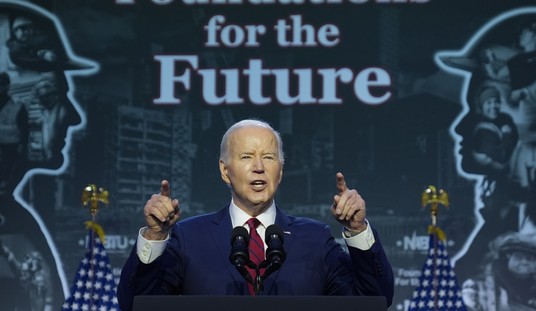Last week, I asked whether or not the concept of the “Greatest Generation” has done more harm than good, making us reluctant to point out that otherwise admirable cohort’s failings.
I now present my promised “Worst” of the “Greatest” roundup.
As always, your mileage may vary. I invite your nominations and dissents (and any ideas for future lists) in the comments.
3. HOWARD ZINN
In other words, what Zinn offers us is not a corrective, but a distortion. It is as if someone said to you “Would you like to see Versailles?” and then took you on a tour of a broken shed on the outskirts of the palace grounds. “You see, pretty shabby, isn’t it?”
Howard Zinn has wrecked more Thanksgiving dinners than salmonella.
For decades, freshmen have made their first trips back home from college and regaled their fuming families with “the truth” about America’s treatment of the Indians. Heck, even the fictional Sopranos had to deal with this stuff:
Tony’s kid informs him that they don’t celebrate [Columbus Day] at school, because Columbus was a practitioner of genocide against the Indian natives in the new land. When Tony asks him where he got that from, he tells him it was from their school textbook , Zinn’s People’s History.
Howard Zinn’s A People’s History of the United States is required reading at colleges across America and has sold millions of copies, mostly to impressionable teens who go on to become insufferable adults: those smug “progressives” who end up as public employees, politicians, journalists and other media mavens, non-profit employees, “artists,” movie stars, and, of course, teachers.
The next time you hear Whoopi Goldberg insist that the Japanese Army (she meant “Navy”) bombed Pearl Harbor (and probably had a good reason), blame Howard Zinn.
When your adolescent nephew (or perenially unemployed middle-aged brother-in-law) declares with an audible sniff that every war in history was “really about greed” (including the Civil War and World War II), blame Howard Zinn.
“9/11 was an inside job”? Not all Zinn’s fault, but he helped.
If it makes your blood boil; is partially encased in sarcastic “scare quotes”; is intentionally hyperbolic and nitpicking, and therefore said mostly to annoy (and make the speaker feel unjustifiably superior); if it contradicts common knowledge, human nature, the laws of physics, and your own personal experience; if it sounds a lot like something Oliver Stone would make a movie about, or already has — then chances are, it’s an historical tidbit that’s been helpfully predigested by someone influenced by Zinn, whether they know it or not.
Zinn (1922-2010) actually boasted that his books were biased, calling objectivity both “impossible” then adding, “if it were possible, it would be undesirable.”
Naturally, he didn’t brag that A People’s History and his other writings were also marred by factual errors and underpinned by dubious or discredited scholarship.
He claims, for instance, that “unemployment grew in the Reagan years.” False, as anyone who lived in America during that administration can tell you; after considerable fluctuation, the rate was only 5.4% when Reagan left office.
Better yet, youngsters are blithely informed by Zinn that “George Washington was the richest man in America” – a fib that sounds just as corny as the claims by previous generations of pop historians that Boy Washington was plagued with guilt after chopping down a cherry tree.
Zinn lovingly dwells on the gory details of those atrocities committed against native Americans, but omits the crimes committed by natives on settlers – and each other.
Zinn’s whoppers are the key source for my cynical assertion that if other shameless, world-historical lies are any indication, we’ll find out one day that the Scottsboro boys were guilty. After all, Zinn’s account of that Depression era cause celebre omits the contemporaneous remark made by a Communist Party member to a black reporter:
[W]e don’t give a damn about the Scottsboro boys. If they burn it doesn’t make any difference. We are only interested in one thing, how we can use the Scottsboro case to bring the Communist movement to the people and win them over to Communism.
And Zinn was only interested in the very same thing. His FBI files were made public after his death, and you’ll never guess!
First, the FBI had evidence that Zinn was a member of the Communist Party of the United States, and lied about his membership when being interviewed by FBI agents. The first file on the subject appeared in March of 1949, when an informant noted “that he (ZINN) is a Communist Party member and attends meetings five days a week.” Zinn was then employed by the American Labor Party … (which)never would have hired non-Party members as full-time employees.
Next time you’re trapped around a long table, staring at a desiccated turkey carcass and trying not to stab that skinny, mouthy homecoming kid with the nearest dessert fork, give them a little factoid of your own to chew on:
A People’s History of the United States is over 700 pages long – and even though it is assigned year in and year out as a college textbook, each of those pages “contains not a single source citation” or footnote.
http://www.youtube.com/watch?v=-jTmgLgDEo4
2. BETTY FRIEDAN
I’m going to add that very few people now actually remember what it was like during the period of the feminist movement. Everything was up for grabs. No one knew what to do or how to do it. Betty Friedan ruined a Super Bowl party in my very own home by wearing a black leather miniskirt and swinging her (not bad) legs clad in fishnet stockings back and forth in front of the TV screen so that nobody could see the plays. She radicalized a sizable bunch of neutral men into committed anti-feminists that day.
— Carolyn See, Washington Post
Stop me if you’ve heard this one:
A radical leftist pretends to be something they aren’t and writes a book packed with twisted “statistics” and hair-raising anecdotes. The book sells millions of copies — and ruins countless lives, but years later, liberals still consider it a “classic” and praise the author as a brave revolutionary.
OK, so I just described the history of the last hundred years. But since (as feminists never tire of repeating) women make up half the world, I’ll single out the horrible “Greatest Generation” member who arguably screwed up the largest number of people.
Betty Friedan (born 1921) masqueraded as a typical suburban housewife who just up and rebelled one day in the early 1960s. Her resulting book, The Feminine Mystique, became a clarion call to housewives everywhere to throw off their aprons and demand independence from the stifling patriarchy through, er, “consciousness raising” and stuff…
(Please note: no one really “burned their bras” until somebody claimed falsely that somebody else had…)
Friedan called this supposed simmering discontentment plaguing millions of American females “the problem that has no name” – an ingenious way to disguise the fact that, since her thesis only concerned college educated, white, middle class females, it was hardly a national epidemic. (My definition of “social justice” being “the stubborn application of unworkable solutions to imaginary problems.”)
And while his famous Law was still a glint in Godwin’s eye, Friedan famously described suburban life as a “comfortable concentration camp.” She also popularized the notion that “the personal is political.”
A talented coiner of phrases, Friedan could have had a decent career in marketing and advertising. Despite her dogged insistence to the contrary, women did in fact work in that industry, and others, during her time and well beforehand. Ironically, Friedan ultimately earned more money and power than any of those pioneering white collar females — by writing a book that strongly suggested they didn’t exist.
Like too many people with an easy facility with words, however, Friedan’s glib coinages often possessed more style than substance.
Take her oft-repeated assertion in The Feminine Mystique that:
Vacuuming the living room floor — with or without makeup — is not work that takes enough thought or energy to challenge any woman’s full capacity. Down through the ages man has known that he was set apart from other animals by his mind’s power to have an idea, a vision, and shape the future to it … when he discovers and creates and shapes a future different from his past, he is a man, a human being.
True, but not very original. For reasons related to either incuriosity or intellectual dishonesty, Friedan didn’t follow her line of inquiry down a more fascinating path: why hadn’t women been the ones who invented the vacuum cleaner, and all the other “labor saving devices” they used every day – the ones that gave the lie to her “comfortable concentration camp” notion?
The very question (let alone the answers) would have cost Friedan her burgeoning career as the public face of “women’s lib.” As blogger Kate McMillan likes to say, “If women ran the world, mankind would still be living in caves, albeit with really, really fancy curtains.” That is: invention “just isn’t in our nature.” (See “Charles Kettering liberated more women than Betty Friedan and Gloria Steinem.”)
Compared to curing diseases or building railroads, writing a book isn’t that tough. And Friedan’s musings about women’s place in the world weren’t even that original. Jean Paul Sartre’s pimp-consort Simone de Beauvoir beat her to it, with The Second Sex back in 1949.
(In fact, had someone bothered to notice: Friedan’s insistence on “analyzing” articles about “working women” and “how to be the perfect wife” from popular women’s magazines would indicate that, obviously, the writers of those articles had thought of this stuff before she had.)
I mean, look – here’s Bette Davis in the critically acclaimed smash hit All About Eve, back in 1950:
Still, given that the job doesn’t necessarily demand philosophical rigour or even integrity, Friedan really would have made a great Madison Avenue phrase-maker. Except that she was a Communist – something she left out of her semi-autobiographical book and press materials:
Betty Friedan’s secret was, of course, shared by hundreds of her comrades on the left, who went along with her charade presumably in order to assist her political agendas with the unsuspecting American public. (…) Friedan, from her college days and until her mid-thirties, was a Stalinist Marxist (or a camp follower thereof), the political intimate of leaders of America’s Cold War fifth column, and for a time even the lover of a young Communist physicist working on atomic bomb projects with J. Robert Oppenheimer. Not at all a neophyte when it came to “the woman question” (the phrase itself is a Marxist construction), she was certainly familiar with the writings of Engels, Lenin and Stalin on the subject and had written about it herself as a journalist for the official publication of the Communist-controlled United Electrical Workers union.
It gets better, and I’ll bet you can guess how, Al Gore Michael Moore. Friedan was a Communist who also happened to live in a mansion (complete with a maid). Presenting herself as an independent feminist, she was supported by her (now ex-)husband, whom she once accused of abusing her. (He countered that it was the other way around.)
Friedan famously shouted at her frequent debating partner during the 1970s, conservative pioneer Phyllis Schlafly: “I’d like to burn you at the stake.” But even in those heady days, Friedan revealed some surprising views. Troubled by the growing radicalization and separatism of the women’s movement she’d helped created, Friedan called lesbianism “a lavender menace” that could kill off organized feminism’s mainstream appeal.
In her follow up book, 1981’s The Second Stage, Friedan regretted that feminism had come to deny “that core of women’s personhood that is fulfilled through love, nurture, home.” That kind of talk led Susan Faludi and other Third Wave feminists to call Friedan a traitor and a has-been.
Maybe her vitriolic reaction to Schlafy’s unflappable resolve was sparked by Friedan’s other secret: the dreadful realization that she and her “enemy” were more alike than she wanted to admit.
You Young People Today® are probably thinking:
“OK, Jimmy Carter (born 1924) hates Israel and loves terrorists and dictators – but he also does that Habitat for Humanity stuff, so what’s the big deal?”
Oh, you kids! Gather ‘round and listen to your Auntie Kathy tell you about the 1970s.
I was a kid in the early 1970s, so I didn’t understand what Watergate was about. (In my defense, neither did most of the grown ups.) If the assassinations of the 1960s had been heart attacks, Watergate was the stroke that almost finished America off.
In 1976, the Democrats could have run a dead hamster for president and won. They put up Jimmy Carter and it sounded genius: a Washington “outsider,” an evangelical Christian, a Naval officer turned peanut farmer with a big smile and a hickish extended family to provide some much-needed comic relief:
He has a mother who runs off to India at age 68, a daughter who lives in a tree house, aides who don’t wear underwear, a sister who rides a motorcycle, a brother who drinks ten six-packs of beer a day, and another sister who is a faith healer.
Holy hell.
My economics textbooks at the time said you never have inflation and unemployment at once. Not only was Carter rendering these textbooks obsolete while I was turning their pages (a creepy feeling, believe me), the economy was so bad they had to invent a new word for it: “stagflation” — inflation, unemployment, and high, double-digit interest rates in a three-legged race off a cliff.
I picked Jimmy Carter for my #1 spot, for the completely subjective and personal reason that, after 9/11, I started saying, “I blame Jimmy Carter” and never stopped. His serial stupidity about Iran — from his too-tight embrace of the shah to the bumbling of the embassy seize — laid the foundation for Osama’s “weak horse” view of America. (It is no coincidence that a suddenly panic-stricken Iran freed those hostages in the middle of Reagan’s 1980 inaugural address.)
You’d think someone that notoriously inept would sneak back to Plains, Georgia, and never show his grinning face in public again.
Yet once again, America had misjudged Jimmy Carter. The “nice guy” revealed a surly bitter side that shocks even now, if like me you remember his whimsical campaign merch, and the relief with which his election was greeted.
I never thought America would let itself get fooled like that again.
That said, remember: after Carter, came Reagan.
Just keep repeating that over and over again. I find it helps a little.











Join the conversation as a VIP Member